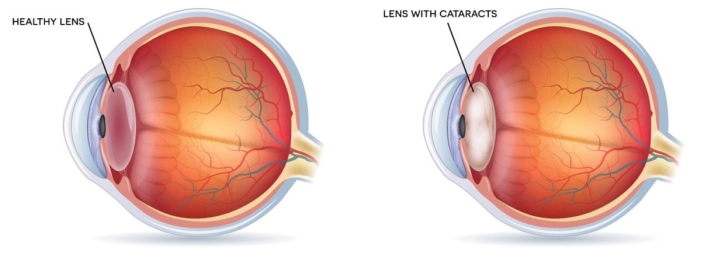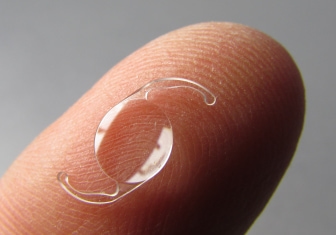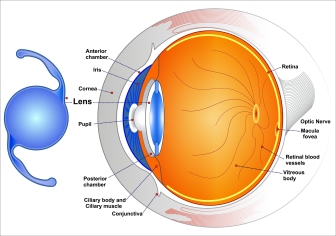A cataract is a cloudy area in the lens of the eye. The lens is located behind the pupil. In the normal eye, the lens is clear. It acts like the lens of a camera, focusing light onto the retina. The retina changes the light into nerve signals, these signals travel along the optic nerve to the brain, and the brain interprets them as images. If the lens is not clear, light passing through it will be scattered instead of focused, and vision will be blurry.
Cataracts are very common in people with Aniridia, occuring in 50-85 percent of individuals. Cataracts may be present at birth or they may develop later in life. Cataracts can also change over the course of a person's life, becoming larger or more dense over time.
The effect of a cataract on vision depends on its type, size, position, and density. For example, some cataracts are small and located in the outer portion of the lens. These cataracts may have little impact on functional vision. However, if a cataract is large, dense, and located in the center of the lens, it can significantly impair vision.
Cataract surgery is one of the most common procedures performed worldwide. However, surgeons and patients or parents should be familiar with the additional risks posed by Aniridia, to ensure the best possible outcomes. See Special Considerations below

Congenital cataracts (present at birth) are common in people with Aniridia. If the cataract is not obstructing vision, removal is not required. Cataracts may also develop after birth. Anterior polar cataracts and posterior subcapsular cataracts are the most common, but other types may also be seen.
Cataracts that are large, dense, and centrally positioned may significantly obstruct vision. When this occurs, surgery is needed to restore usable vision.
Surgery to remove cataracts is done by making a small incision in the side of the cornea, and removing the lens of the eye. After the natural lens is removed, an intraocular lens (IOL) may be implanted. In some cases, an IOL that corrects refractive errors (near-sightedness, far-sightedness, or astigmatism) may be used if needed.
In some cases, it is not possible to implant an IOL at the time of cataract removal. Without a lens in the eye (called aphakia), most patients will need high-powered eyeglasses.
Artificial Iris Patients with Aniridia who undergo cataract surgery may be offered the option of an artificial iris, a prosthetic device made of flexible silicone. This device has been approved by the US Food and Drug Administation for patients with Aniridia, but may not be covered by health insurance (in the US) and its use remains controversial.
The benefits of an artificial iris include improvement of the cosmetic appearance of the eye and a reduction in glare. However, these benefits must be weighed against the potential for loss of vision due to complications from the procedure.
See Special Considerations

Intraocular Lens (IOL)

Placement of IOL
If present, the following conditions can make cataract surgery more complex in a patient with Aniridia:
Aniridic eyes also have an increased risk of serious complications following any intraocular (inside the eye) surgical procedure, including:
The risk for these complications increases in eyes that have undergone multiple surgeries.
The benefits of cataract removal may outweigh the risks for patients whose vision is substantially decreased by large or central cataracts. In these cases, cataract removal can restore usable vision. It is important for surgeons to be aware of the abnormalities and potential complications associated with Aniridia, and to be prepared to manage these.
Patients and parents are advised to discuss the risks and benefits of cataract surgery with their ophthalmologist in order to make informed decisions about care.
Sign up for News & Events
COPYRIGHT© 2025 IWSA / International WAGR Syndrome Association
